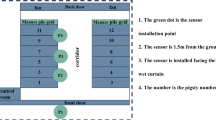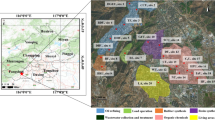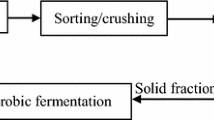Abstract
Chemical components of airborne volatile organic compounds (VOCs) released from a wastewater treatment system of the tapioca industry were identified. Quantitative analysis of the concentrations and the emissions of each chemical were evaluated taking into consideration the difference in atmospheric turbulence over the surface of the wastewater during the day and the nighttime periods. The chamber experiments were performed on-site in order to reflect actual environmental characteristics of the study area. Chemical concentrations were analyzed following the U.S. EPA TO-15 Standard Method. Emissions of each compound were calculated using the box model scheme. It was found that acetaldehyde and acetone were two major compounds of released airborne VOCs from the wastewater treatment system of the tapioca industry. Due to its high organic content, the wastewater treatment facilities of this type of factory generally caused the odor problem to its surrounding communities. These data were then used to evaluate the success of implementing the Clean Development Mechanisms project in this industry. Reduction in the affected area from odor by improving the wastewater treatment system from opened lagoons which is the type of common practice in most of the tapioca factories in the developing countries to the modified covered lagoons was evaluated. These results supported the theory of the co-benefit of managing both local environmental problems and reduction of greenhouse gas emissions from the implementation of cleaner technology in the agro-industry. This methodology can be applied to reveal and quantify the success of other green efforts particularly in the agro-industry businesses.
Graphical abstract






Similar content being viewed by others
References
Aatamila M, Verkasalo PK, Korhonen MJ, Suominen AL, Hirvonen MR, Viluksela MK, Nevalainen A (2011) Odour annoyance and physical symptoms among residents living near waste treatment centres. Environ Res 111:164–170. https://doi.org/10.1016/j.envres.2010.11.008
Adetunji AR, Isadare DA, Akinluwade KJ, Adewoye OO (2015) Waste-to-wealth applications of cassava—a review study of industrial and agricultural applications. Biometrical J 4:212–229. https://doi.org/10.9734/AIR/2015/15417
Admassu M, Wubeshet M (2006) Air pollution: lecture notes for environmental health science students. University of Gondar Publications, Ethiopia. http://www.cartercenter.org/resources/pdfs/health/ephti/library/lecture_notes/env_health_science_students/Airpollution.pdf. Accessed 20 October 2015
Agus E, Zhang L, Sedlak LD (2012) A framework for identifying characteristic odor compounds in municipal wastewater effluent. Water Res 46:5970–5980. https://doi.org/10.1016/j.watres.2012.08.018
Alfonsin C, Lebrero R, Estrada JM, Munoz R, Kraakman NJR, Feijo G, Moreira MT (2015) Selection of odour removal technologies in wastewater treatment plants: a guideline based on life cycle assessment. Environ Manag 149:77–84. https://doi.org/10.1016/j.jenvman.2014.10.011
Andersson MJE, Andersson L, Bende M, Millqvist E, Nordin S (2009) The idiopathic environmental intolerance symptom inventory: development, evaluation, and application. J Occup Environ Med 51:838–847. https://doi.org/10.1097/JOM.0b013e3181a7f021
Atasoy E, Dogeroglu T, Kara S (2004) The estimation of NMVOC emissions from an urban-scale wastewater treatment plant. Water Res 38:3265–3274. https://doi.org/10.1016/j.watres.2004.04.036
Baawain M, Al-Mamum A, Omidvarborna H, Al-Jabri A (2017) Assessment of hydrogen sulfide emission from a sewage treatment plant using AERMOD. Environ Monit Assess 189:263–273. https://doi.org/10.1007/s10661-017-5983-6
Bruno P, Caselli M, de Genaro G, Solito M, Tutino M (2007) Monitoring of odor compounds produced by solid waste treatment plants with diffusive samplers. Waste Manag 27:539–544. https://doi.org/10.1016/j.wasman.2006.03.006
Capelli L, Sironi S, Rosso RD, Centola P (2009) Predicting odour emissions from wastewater treatment plants by mean emission factors. Water Res 43:1977–1985. https://doi.org/10.1016/j.watres.2009.01.022
Fang JJ (2012) Odor compounds from different sources of landfill: characterization and source identification. Waste Manag 32:1401–1410. https://doi.org/10.1016/j.wasman.2012.02.013
Gallego E, Roca FJ, Perales JF, Sanchez G, Esplugas P (2012) Characterization and determination of the odorous charge in the indoor air of a waste treatment facility through the evaluation of volatile organic compounds (VOCs) using TD-GC/MS. Waste Manag 32:2469–2481. https://doi.org/10.1016/j.wasman.2012.07.010
Grosch W (2001) Evaluation of the key odorants of foods by dilution experiments, aroma models and omission. Chem Senses 26:533–545. https://doi.org/10.1093/chemse/26.5.533
Hermann A (2010) Volatiles—an interdisciplinary approach. In: Herrmann A (ed) The chemistry and biology of volatiles. Wiley, Hoboken
Lee HD, Jeon SB, Choi WJ, Lee SS, Lee MH, Oh KJ (2013) A novel assessment of odor sources using instrumental analysis combined with resident monitoring records for an industrial area in Korea. Atmos Environ 74:277–290. https://doi.org/10.1016/j.atmosenv.2013.04.001
Li P, Zhu M (2011) A consolidated bio-processing of ethanol from cassava pulp accompanied by hydrogen production. Biores Technol 102:10471–10479. https://doi.org/10.1016/j.biortech.2011.08.134
Li S, Cui Y, Zhou Y, Luo Z, Liu J, Zhao M (2017) The industrial applications of cassava: current status, opportunities and prospects. J Sci Food Agric 97:2282–2290. https://doi.org/10.1002/jsfa.8287
Mackie RI, Stroot PG, Varel VH (1998) Biochemical identification and biological origin of key odour components in livestock waste. Anim Sci 76:1331–1342
Management Industry System (MIS) (2006) Guideline for eco-efficiency native starch industry. The Bureau of Technology and Industrial Pollution Management of the Department of Industrial Works, Ministry of Industry, Thailand
Ni JQ (2015) Research and demonstration to improve air quality for the U.S. animal feeding operation in the 21st century—a critical review. Environ Pollut 200:105–119. https://doi.org/10.1016/j.envpol.2015.02.003
Nicell JA (2009) Assessment and regulation of odour impacts. Atmos Environ 43:196–206. https://doi.org/10.1016/j.atmosenv.2008.09.033
O’Shauhnessy PT, Altimer R (2011) Use of AERMOD to determine a hydrogen sulfide emission factor for swine operations by inverse modeling. Atmos Environ 45:4617–4625. https://doi.org/10.1016/j.atmosenv.2011.05.061
Obadina AO, Oyewole OB, Sanni LO, Abiola SS (2006) Fungal enrichment of cassava peels proteins. Afr J Biotechnol 5(3):302–304
Powers WJ, Kempen VT, Bundy DS, Sutton A, Hoff SJ (2000) Objective measurement of odours using gas chromatography/mass spectrometry and instrumental technologies. In: Air pollution from agricultural operations, proceedings of the second international conference, pp 33–41
Rajbansi B, Sarkar U, Hobbs SE (2014) Hazardous odor markers from sewage wastewater: a step towards simultaneous assessment, dearomatization and removal. Taiwan Inst Chem Eng 45:1549–1557. https://doi.org/10.1016/j.jtice.2013.10.004
Rajbhandari BK, Annachhatre AP (2004) Anaerobic ponds treatment of starch wastewater: case study in Thailand. Biores Technol 95(2):135–143. https://doi.org/10.1016/j.biortech.2004.01.017
Rappert S, Muller R (2005) Odor compounds in waste gas emissions from agricultural operations and food industries. Waste Manag 25:887–907. https://doi.org/10.1016/j.wasman.2005.07.008
Saeaw N, Thepanondh S (2015) Source apportionment analysis of airborne VOCs using positive matrix factorization in industrial and urban areas in Thailand. Atmos Pollut Res 6:644–650. https://doi.org/10.5094/APR.2015.073
Schauberger G, Piringer M, Petz E (2001) Separation distance to avoid odour nuisance due to livestock calculated by the Austrian odour dispersion model (AODM). Agr Ecosyst Environ 87:13–28. https://doi.org/10.1016/S0167-8809(00)00299-1
Schauberger G, Piringer M, Petz E (2006) Odour episodes in the vicinity of livestock buildings: a qualitative comparison of odour complaint statistics with model calculations. Agr Ecosyst Environ 114:185–194. https://doi.org/10.1016/j.agee.2005.10.007
Schauberger G, Piringer M, Heber AJ (2014) Odour emission scenarios for fattening pigs as input for dispersion models: a step from an annual mean value to time series. Agr Ecosyst Environ 193:108–116. https://doi.org/10.1016/j.agee.2014.04.030
Shaw AR, Koh SH (2013) Gaseous emissions from wastewater facilities. Water Environ Res 85:1298–1307. https://doi.org/10.2175/106143013X13698672322147
Stuetz RM, Nicolas J (2001) Sensor arrays: an inspired idea or and objective measurement of environmental odours. Water Sci Technol 44(9):53–58
Sucker K, Both R, Winneke G (2001) Adverse effects of environmental odours: reviewing studies on annoyance responses and symptom reporting. Water Sci Technol 44(9):43–51
Sun F, Yun D (2017) Yu X (2017) Air pollution, food production and food security: a review from the perspective of food system. J Integr Agric 16(12):2945–2962. https://doi.org/10.1016/S2095-3119(17)61814-8
Thepanondh S, Varoonphan J, Sarutichart P, Makkasap T (2011) Airborne volatile organic compounds and their potential health impact on the vicinity of petrochemical industrial complex. Water Air Soil Pollut 214:83–92. https://doi.org/10.1007/s11270-010-0406-0
Tian HZ, Gao JJ, Hao JM, Lu L, Zhu CY, Qiu PP (2013) Atmospheric pollution problems and control proposals associated with solid waste management in China: a review. J Hazard Mater 15:142–154. https://doi.org/10.1016/j.jhazmat.2013.02.013
Ubalua AO (2007) Cassava wastes: treatment options and value addition alternatives. Afr J Biotechnol 6(18):2065–2073. https://doi.org/10.5897/AJB2007.000-2319
United Nations Framework Convention on Climate Change (UNFCCC) (2013) The United Nations framework convention on climate change conference 2013. Clean Development Mechanism (CDM): project search. http://cdm.unfccc.int/Projects/DB/DNV-CUK1354873476.07/view. Accessed 10 October 2016
United States Environmental Protection Agency (USEPA) (2004) AERMOD: Description of model formulation. http://www3.epa.gov/scram001/7thconf/aermod/aermod_mfd.pdf. Accessed 24 October 2015
Van Harreveld AP (2001) From odorant formation to odour nuisance: new definitions for discussing a complex process. Water Sci Technol 44(9):9–15
Wu BZ, Feng TZ, Sree U, Chiu KH, Lo JG (2006) Sampling and analysis of volatile organics emitted from wastewater treatment plant and drain system of an industrial science park. Anal Chim Acta 576:100–111. https://doi.org/10.1016/j.aca.2006.03.057
Zarra T, Naddeo V, Belgiorno V, Reiser M, Kranert M (2008) Odour monitoring of small wastewater treatment plant located in sensitive environment. Water Sci Technol 58:89–94. https://doi.org/10.2166/wst.2008.330
Zhu YL, Zheng GD, Gao D, Chen TB, Wu FK, Niu MJ, Zou KH (2016) Odor composition analysis and odor indicator selection during sewage sludge composting. J Air Waste Manag Assoc 66(9):930–940. https://doi.org/10.1080/10962247.2016.1188865
Acknowledgements
The authors sincerely thank K. S. Chanthaburi Co., Ltd., for the assistance and support by providing the data and collaborating the site for this case study and M. L. Sattler for the helpful comments that improved the manuscript. Financial support of this research was granted by Research and Researcher for Industry (Ph.D. program, grant number PHD58I0031), the Thailand Research Fund. Authors would also like to extend their appreciation to the Environmental Research and Training Center (ERTC) for providing instruments of sampling and facilities for analyzing samples. This study was partially supported for publication by the China Medical Board (CMB), Center of Excellence on Environmental Health and Toxicology (EHT), Faculty of Public Health, Mahidol University, Thailand. The proofreading of this manuscript was supported by the Editorial Office, Faculty of Graduate Studies, Mahidol University.
Author information
Authors and Affiliations
Corresponding author
Electronic supplementary material
Below is the link to the electronic supplementary material.
Rights and permissions
About this article
Cite this article
Wimolrattanasil, T., Thepanondh, S., Sattler, M.L. et al. Quantitative evaluation of cleaner production and environmental policy toward the co-benefit of greenhouse gas and odor reduction: case study of Tapioca starch industry. Clean Techn Environ Policy 20, 2333–2343 (2018). https://doi.org/10.1007/s10098-018-1609-0
Received:
Accepted:
Published:
Issue Date:
DOI: https://doi.org/10.1007/s10098-018-1609-0




